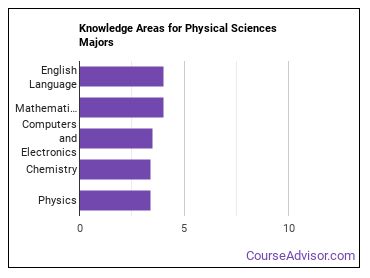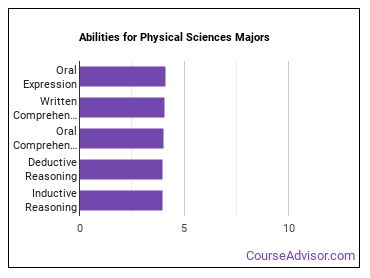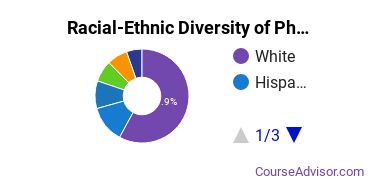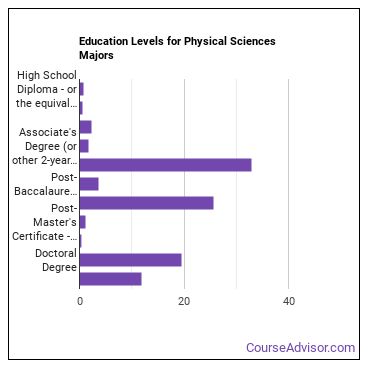Physical Sciences
Types of Degrees Physical Sciences Majors Are Getting
The following table lists how many physical sciences graduations there were for each degree level during the last year for which data was available.
| Education Level | Number of Grads |
|---|---|
| Bachelor’s Degree | 28,585 |
| Master’s Degree | 7,174 |
| Doctor’s Degree | 6,581 |
| Associate Degree | 4,829 |
| Basic Certificate | 258 |
| Graduate Certificate | 256 |
| Undergraduate Certificate | 26 |
What Physical Sciences Majors Need to Know
People with careers related to physical sciences were asked what knowledge areas, skills, and abilities were important for their jobs. They weighted these areas on a scale of 1 to 5 with 5 being the highest.
Knowledge Areas for Physical Sciences Majors
According to O*NET survey takers, a major in physical sciences should prepare you for careers in which you will need to be knowledgeable in the following areas:

- English Language - Knowledge of the structure and content of the English language including the meaning and spelling of words, rules of composition, and grammar.
- Mathematics - Knowledge of arithmetic, algebra, geometry, calculus, statistics, and their applications.
- Computers and Electronics - Knowledge of circuit boards, processors, chips, electronic equipment, and computer hardware and software, including applications and programming.
- Chemistry - Knowledge of the chemical composition, structure, and properties of substances and of the chemical processes and transformations that they undergo. This includes uses of chemicals and their interactions, danger signs, production techniques, and disposal methods.
- Physics - Knowledge and prediction of physical principles, laws, their interrelationships, and applications to understanding fluid, material, and atmospheric dynamics, and mechanical, electrical, atomic and sub- atomic structures and processes.
Skills for Physical Sciences Majors
When studying physical sciences, you’ll learn many skills that will help you be successful in a wide range of jobs - even those that do not require a degree in the field. The following is a list of some of the most common skills needed for careers associated with this major:

- Reading Comprehension - Understanding written sentences and paragraphs in work related documents.
- Critical Thinking - Using logic and reasoning to identify the strengths and weaknesses of alternative solutions, conclusions or approaches to problems.
- Speaking - Talking to others to convey information effectively.
- Active Listening - Giving full attention to what other people are saying, taking time to understand the points being made, asking questions as appropriate, and not interrupting at inappropriate times.
- Writing - Communicating effectively in writing as appropriate for the needs of the audience.
Abilities for Physical Sciences Majors
As you progress with your physical sciences degree, there are several abilities you should pick up that will help you in whatever related career you choose. These abilities include:

- Oral Expression - The ability to communicate information and ideas in speaking so others will understand.
- Written Comprehension - The ability to read and understand information and ideas presented in writing.
- Oral Comprehension - The ability to listen to and understand information and ideas presented through spoken words and sentences.
- Deductive Reasoning - The ability to apply general rules to specific problems to produce answers that make sense.
- Inductive Reasoning - The ability to combine pieces of information to form general rules or conclusions (includes finding a relationship among seemingly unrelated events).
What Can You Do With a Physical Sciences Major?
Below is a list of occupations associated with physical sciences:
| Job Title | Job Growth Rate | Median Salary |
|---|---|---|
| Atmospheric and Space Scientists | 12.5% | $94,110 |
| Atmospheric, Earth, Marine, and Space Sciences Professors | 9.9% | $90,860 |
| Chemistry Professors | 9.9% | $79,550 |
| Chemists | 6.5% | $76,890 |
| Clinical Research Coordinators | 9.9% | $123,860 |
| Environmental Science Professors | 10.1% | $79,910 |
| Environmental Scientists and Specialists, Including Health | 11.1% | $71,130 |
| Geoscientists, Except Hydrologists and Geographers | 14.1% | $91,130 |
| Hydrologists | 10.4% | $79,370 |
| Industrial Ecologists | 11.1% | $71,130 |
| Natural Sciences Managers | 9.9% | $123,860 |
| Physicists | 14.5% | $120,950 |
| Physics Postsecondary Professors | 10.2% | $90,800 |
| Remote Sensing Scientists and Technologists | 6.8% | $107,230 |
| Secondary School Teachers, Except Special and Career/Technical Education | 7.5% | $60,320 |
| Water Resource Specialists | 9.9% | $123,860 |
Who Is Getting a Bachelor’s Degree in Physical Sciences?
Racial-Ethnic Diversity
At the countrywide level, the racial-ethnic distribution of physical sciences majors is as follows:

| Race/Ethnicity | Number of Grads |
|---|---|
| Asian | 2,783 |
| Black or African American | 1,426 |
| Hispanic or Latino | 3,811 |
| White | 16,387 |
| International Students | 2,025 |
| Other Races/Ethnicities | 2,153 |
Geographic Diversity
Americans aren’t the only ones with an interest in Physical Sciences. About 7.1% of those with this major are international students.
Amount of Education Required for Careers Related to Physical Sciences
Some degrees associated with physical sciences may require an advanced degree, while others may not even require a bachelor’s in the field. Whatever the case may be, pursuing more education usually means that more career options will be available to you.
Find out what the typical degree level is for physical sciences careers below.

| Education Level | Percentage of Workers |
|---|---|
| High School Diploma - or the equivalent (for example, GED) | 0.8% |
| Post-Secondary Certificate - awarded for training completed after high school (for example, in agriculture or natural resources, computer services, personal or culinary services, engineering technologies, healthcare, construction trades, mechanic and repair technologies, or precision production) | 0.5% |
| Some College Courses | 2.3% |
| Associate’s Degree (or other 2-year degree) | 1.7% |
| Bachelor’s Degree | 33.0% |
| Post-Baccalaureate Certificate - awarded for completion of an organized program of study; designed for people who have completed a Baccalaureate degree but do not meet the requirements of academic degrees carrying the title of Master. | 3.5% |
| Master’s Degree | 25.7% |
| Post-Master’s Certificate - awarded for completion of an organized program of study; designed for people who have completed a Master’s degree but do not meet the requirements of academic degrees at the doctoral level. | 1.2% |
| First Professional Degree - awarded for completion of a program that: requires at least 2 years of college work before entrance into the program, includes a total of at least 6 academic years of work to complete, and provides all remaining academic requirements to begin practice in a profession. | 0.3% |
| Doctoral Degree | 19.5% |
| Post-Doctoral Training | 11.8% |
Online Physical Sciences Programs
The following table lists the number of programs by degree level, along with how many schools offered online courses in the field.
| Degree Level | Colleges Offering Programs | Colleges Offering Online Classes |
|---|---|---|
| Certificate (Less Than 1 Year) | 0 | 0 |
| Certificate (1-2 years) | 62 | 4 |
| Certificate (2-4 Years) | 2 | 0 |
| Associate’s Degree | 1,448 | 74 |
| Bachelor’s Degree | 222 | 36 |
| Post-Baccalaureate | 0 | 0 |
| Master’s Degree | 2,216 | 44 |
| Post-Master’s | 38 | 0 |
| Doctor’s Degree (Research) | 1,618 | 4 |
| Doctor’s Degree (Professional Practice) | 6 | 0 |
| Doctor’s Degree (Other) | 0 | 0 |
Explore Major by State
Alabama
California
District of Columbia
Idaho
Kansas
Maryland
Mississippi
Nevada
New York
Oklahoma
South Carolina
Utah
West Virginia
Alaska
Colorado
Florida
Illinois
Kentucky
Massachusetts
Missouri
New Hampshire
North Carolina
Oregon
South Dakota
Vermont
Wisconsin
Majors Related to Physical Sciences
You may also be interested in one of the following majors related to physical sciences.
| Major | Number of Grads |
|---|---|
| Engineering | 198,720 |
| Biological & Biomedical Sciences | 180,784 |
| Engineering Technologies | 86,188 |
| Agriculture & Agriculture Operations | 51,081 |
| Mathematics & Statistics | 49,970 |
| Natural Resources & Conservation | 32,106 |
| Architecture & Related Services | 19,716 |
| Science Technologies / Technicians | 6,771 |
| Military Technologies & Applied Sciences | 4,568 |
References
*The racial-ethnic minorities count is calculated by taking the total number of students and subtracting white students, international students, and students whose race/ethnicity was unknown. This number is then divided by the total number of students at the school to obtain the racial-ethnic minorities percentage.
- College Factual
- College Scorecard
- National Center for Education Statistics
- O*NET Online
- U.S. Bureau of Labor Statistics
- Usual Weekly Earnings of Wage and Salary Workers First Quarter 2020
- Image Credit: By NASA under License
More about our data sources and methodologies.
